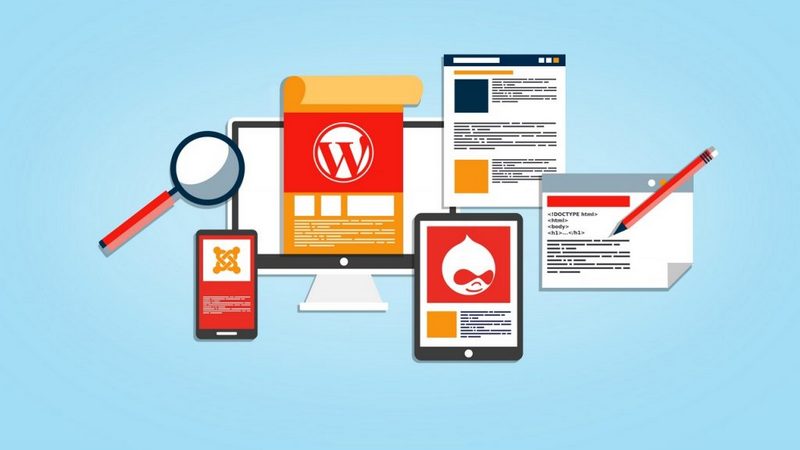It is always important to choose a strong multi-purpose CMS (Content Management System) for your business. In 2018, the most popular decisions are WordPress, Joomla, and Drupal. All three options are free and open-source. They also represent the variety of functionality, extended support, and considerable market share. The last option leads to a large community and a significant range of additional development tools.
It can be hard to see the differences between them and uncover which one is better. Let’s observe key features of each system and find out the best solution for content management tasks in 2018.
WordPress
If you just need the most popular CMS – choose WordPress. According to w3Techs, the average content management system market share of WordPress is 59,5%. And it is used by 32.1% of all the websites in the world. Such numbers are not a joke. For example, Joomla owns only 5,7% and 3,1% worldwide share, respectively. It reveals one of the biggest WP strengths – immense community, continuous support and a great number of tools. More than 55,000 plugins, 6,500+ officially free and 11,000+ premium themes are a huge benefit to every project. Due to its popularity, WP is beginner-friendly. It has the lower entry threshold than the other competitors. Furthermore, WordPress is claimed to be a one-click installation solution. Not only WordPress itself is designed user- and developer-friendly. A great part of plugins and themes are easy to install, use and maintain as well.
Huge market share is a double-edged sword. Thus, WordPress is a delicious target for various malicious actions, including DDoS (Disturbed Denial of Service) and hacker attacks. Actually, security measures provided by WordPress are strong and reliable. They are continuously improving from version to version. The CMS provides a decent number of official and third-party defensive plugins to ensure website’s safety.
In a summary, WordPress is a great decision for fancy websites, blogs, marketplaces, etc… It is a popular, functional, comfortable and customizable CMS.

Joomla
Joomla is the second most popular CMS on the web market. Joomla is a great decision to design and deploy websites of various purposes. These include business, educational, health, government, technology, etc.
Joomla is quite similar to the two other competitors, but it has its own features. This CMS uses templates to implement different designs and graphical features into the website. But the situation is not that simple as it looks. One of the Joomla’s weaknesses is that it has no official template directory. This means that Joomla users need to use only third-party templates to customize the appearance of their products. E.g., you may find more than a 1,000 templates on ThemeForest. Despite this, Joomla provides an official support for thousands of extensions.
Joomla is a safe decision if you can take possible security issues carefully and maintain standard protection measures.

Drupal
Drupal is a tool to create a nice-looking website for everyday usage. It is harder to use than the two other CMSs and may require some programming skills. Despite this fact, it is still easy-to-install. Drupal provides an option of one-click installation.
Drupal is the third popular CMS. It covers only 3,6% of the CMS market share and is used by 2% of all the websites, but the variety of tools eclipses Joomla. You can use more than 41,000 project modules to fulfill your desires and add the wished functionality. 2,500+ official and 500+ premium third-party themes are a decent power to change the visual appearance of the website in the way you like the most.
Every observed content management system has its own strengths and weaknesses. Each system, WordPress, Joomla, and Drupal has its own place under the sun. All three have a solid protection and a huge developing community. Whichever CMS you choose, you will never experience the lack of tools or technical support.
Pick up and analyze your spheres of interest in content management. Inspect the development skills of your team. Determine the best option for your specific needs. These steps will help you to choose the CMS that complies best with all your demands in 2018.



